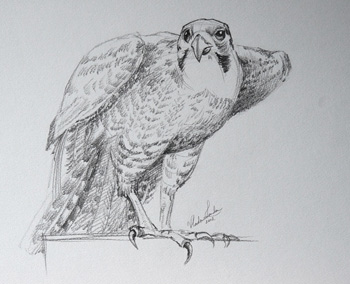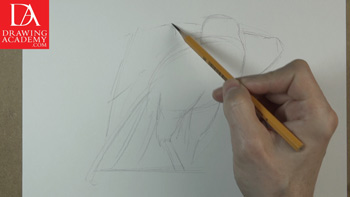Drawing a Bird of Prey
Video Lesson Description
In this video lesson, you will see the Drawing a Bird step-by-step process.
Drawing a Bird of Prey Step by Step
For this “Drawing a Bird” video lesson, I will use the Peregrine Falcon, which has a strongly patterned plumage and a very characteristic shape of the body. The falcon will be sitting on a flat surface just before taking off. Its wings will be half open and the feathers of its tail spread out.
When visiting the National Gallery in London in the mornings, I have often seen the domesticated birds of prey exercising their flight above Trafalgar Square. They were brought there to threaten hundreds of pigeons that used to live and feed at the square. Although the massive number of pigeons was some kind of tourists’ attraction, they polluted fountains and sculptures, so Westminster Council decided to employ their natural predator – a couple of falcons.
Drawing a Bird – First Steps
This bird of prey has relatively long and very strong legs. Falcons hunt medium-sized birds, like pigeons and songbirds, in open air. It uses its legs to strike its prey with clenched feet, stunning or killing it with the impact at a very high speed.
The Peregrine Falcons are renowned for their speed. They hold the record for horizontal cruising speeds of 65-90 kilometers per hour, which is 40-55 mph. They are also incredibly fast when stooping, reaching up to 160-440 kilometers per hour or 99-273 mph!
When drawing a bird, observe the falcon’s wings, which have sharply pointed tips that make its silhouette easily recognizable during flight. Their wing shape is designed for speed.
In this “Drawing a Bird” video, we have a straight-on view of the falcon’s head. Its beak looks foreshortened, which might present some challenge in portraying it from this point of view.
To depict it realistically, you need to visualize its three-dimensional form and draw what you know about such a shape rather copying what you see.
Falcons have very sharp eyesight. At high stooping speed, the falcons use their nictitating membranes, which are the third eyelids, to protect their eyes. These membranes spread tears and clear debris from their eyes while maintaining vision.
Drawing a Bird – Next Steps
When drawing a bird, depict the bird’s eyes in high contrast. It will give a glossy appearance of the eyes.
There are dark feathers on both sides of its beak, which looks like a mustache.
In the wild, Peregrine Falcons live up to 15.5 years. The first year of life is the toughest, with mortality between 59 and 70%. The older the bird becomes, the less likely its life span will be cut short.
The Peregrine Falcon usually has a greyish, brownish or bluish back.
As a fast flying bird, it has long, pointed wings. It has a wingspan twice longer than its body. Falcon’s wings measure from 74 to 120 centimeters (29–47 in). The length of the Peregrine Falcon is 34 to 58 centimeters (13–23 in). The tail measures 13–19 cm (5.1–7.5 in).
The female birds are up to 30% larger than the male, they are also heavier. Female falcons weigh 910 to 1,500 grams (2.0–3.3 lb), while the males weigh 424 to 750 grams (0.93–1.7 lb).
The falcon’s wings are the same color as its back; adult birds usually have a bluish black to a dark grey color on theirs. Wings have hazy, dark stripes.
Drawing a bird, I depict a striped pattern on the bird’s wing, making the tone of the wing lighter than it actually is because the top surface of the wing is well lit with natural light.
The falcon’s tail is usually as dark as its back and wings; it has a well-pronounced barred appearance. I draw stripes of the tail’s feathers darker because we see the core shadow of the tail’s under-plane.
The falcon’s underparts are lighter than its body; they usually are anywhere from a white to rusty color and are barred with dark brown or black stripes.
Drawing a bird of prey is a good way to practice various textures and tones of bird’s feathers.
In the wild, the Peregrine Falcon lives mostly along mountain ranges, river valleys and coastlines. As more land is taken by humans, these birds are adapting to city life.
In urban areas, falcons naturally control the pigeon population. Pigeons make up about 80% of an urban falcon’s diet. The remaining 20% are other common city birds, as well as, insects and on occasion, small mammals like rats, mice and squirrels.
In the wild the falcon’s diet is much more diverse. It is estimated that falcon’s prey on between 1,500 to 2,000 bird species.
The Peregrine Falcon is most active at dawn and dusk, but also can hunt at night in cities and during bird’s migration.
For over 3,000 years the Peregrine Falcon has been used in falconry. Peregrine Falcons have been successfully bred in captivity.
In the second half of the last century, the population of falcons has been reduced due to pesticides. After the ban on some pesticides, it has been gradually increasing, though. Breeding in captivity was also used to release these birds back into the wild.
There are some cultures where falcons are still bred for hunting. In the Western World, falconry serves the purpose of its population recovery, as well as, to control birds in cities and airports.
The barred pattern on the Peregrine Falcon’s breast looks more like a chevron. The color of the bird’s breast is lighter than its back. It has a similar appearance to the underparts.
The underparts are seen in perspective. I draw oval contours that will serve as guides for the underparts pattern. This way, the three-dimensional form will look more realistic and believable.
The Peregrine Falcons have anisodactyl, a distinctive arrangement of their feet. One toe is directed backward while its other three face forward. The bird’s feet have big hooked and sharp claws to grasp its prey in mid-air after the initial strike at high speed with a clenched feet.
Making thorough sketches is a great way to learn about birds and animals in more detail.
- Receive 15 new videos monthly (45 in total)
- Incredible discount – $4,164
- Bonuses - Fine Art eBooks and Videos
- Drawing Academy Diploma of Excellence after course completion in 3 months
- Personal coaching by Drawing Academy Tutors
- Lifetime membership. Free after the 3rd month
- Immediate access to all 45 video lessons
- Incredible discount – $4,198
- Bonuses - Fine Art eBooks and Videos
- Drawing Academy Diploma of Excellence after course completion in 3 months
- Personal coaching by Drawing Academy Tutors
- Lifetime membership. No more payments




